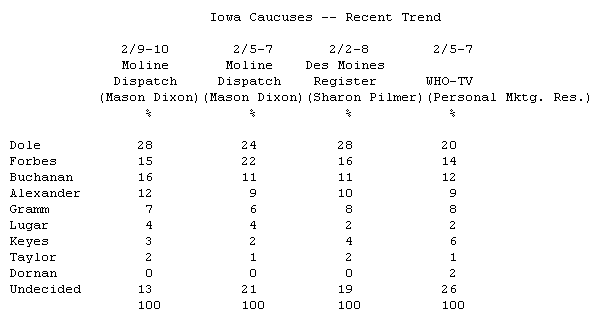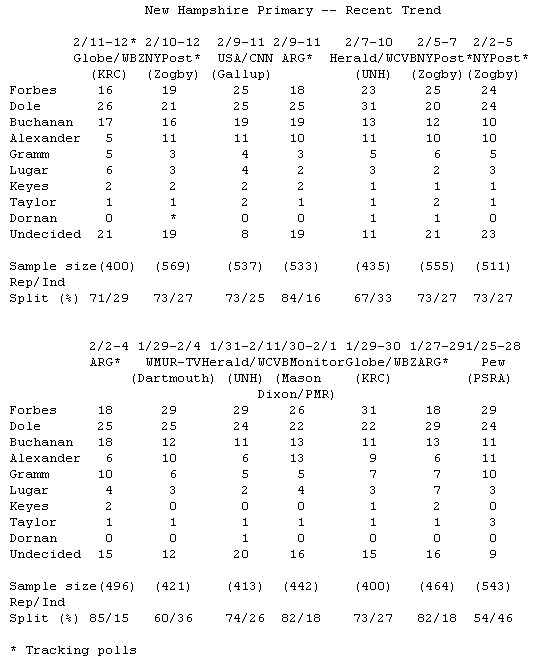Press accounts to the contrary, the polling in both Iowa and New Hampshire has not been particularly volatile. But hold on to your hats. The polling derby goes into overdrive in New Hampshire, as the opinion surveyors attempt to gauge the fallout from Iowa.
In Iowa various polls produced similar results and did a good job of capturing the dynamics of the race, despite the challenge of polling about caucuses. Bob Dole led and Steve Forbes was a weak second place position in the late polls. However, Forbes’ strength was discounted effectively because his support was soft, and because it was more prevalent among independents who fail to show up in large number for caucuses. The Moline Dispatch survey, which was the only poll taken late enough to pick up a post-Louisiana Buchanan surge, did find movement away from Forbes toward Pat Buchanan.

Before Iowa, all the News Hampshire polls, with one consistent exception, showed Forbes catching up to Dole in early February. Only the American Research Group tracking survey found a consistent Dole lead with little indication of gains in voter support for Forbes. It is not possible to explain the reasons for the difference between this poll and the others, because ARG does not provide detailed information about its sampling frame and the demographic composition of its sample.

After Iowa, the daily tracking surveys will most certainly show a sizable boost for Lamar Alexander, who has a positive image there, and a smaller increase for Buchanan, who is viewed less favorably in the Granite state. How much of their gain will be at the expense of Forbes and/or Dole will be closely scrutinized. In watching the polls this week consider the following:
- Independent voters – The percentage of unaffiliated voters in the New Hampshire samples so far has varied a great deal. Independent participation in this primary is an open question, as this is one of the few one party contests in recent New Hampshire history. In 1984 there was only a race for a Presidential nomination in the Democratic primary and in 1964 there was only a Republican contest.
- Daily tracking polls – are better at detecting trends than measuring absolute levels of candidate support. These surveys often under-represent mobile people and people who work unusual hours. Unless potential respondents found “not at home” on the first night are called back subsequently, these one night samples over-represent homebound people.
- Undecideds – levels of no opinion to the preference question will vary from poll to poll depending on whether the surveyors ask a follow up “to whom do you lean” question. Gallup historically does, and is now showing a much lower undecided result (8%) than the other New Hampshire surveys (11% to 23%).
- Strength of support measures – are almost as important in primaries as in caucuses in assessing a candidate’s position in the polls. For example, late Iowa polling found 51% of Buchanan’s supporters strongly committed to him, compared to 36% among Forbes backers.
- Momentum – can come and go. Polls taken early in the week may well exaggerate the real strength of candidates basking in the media attention accorded to those who do better than expected in Iowa. Remember Bob Dole’s short-lived Iowa bounce in 1988?
The Big Poll That Didn’t
The long awaited and well funded “deliberative poll” provided some surprise results which have not been emphasized in the reporting about it. Backers championed this novel exercise as a way to get beyond the “superficial, top-of-the-head answers” that polls provide. But they found just the opposite. For the most part, people from all parts of the country held on to the views that they brought with them to the National Issues Convention in Austin, Texas. More than anything else, the results of the “deliberative poll” provide an empirical testimonial to the robust nature of public opinion as measured in conventional opinion polls.
The deliberative poll was conceived as a representative Town Hall USA. Participants at the convention were chosen by sex, race, income, political preference and other demographic factors to be a microcosm of America. Its originator, James Fishkin of the University of Texas, theorized that after the participants were educated on the details of public policy issues and discussed them with each other, they would reach conclusions that more accurately reflect the electorate’s true views rather than the “superficial views” elicited by ordinary opinion polling. It would be “public opinion as it might be if people became engaged in issues,” as Fishkin put it, as if they “behaved more like ideal citizens.” The true views found via the deliberative poll should then have a “recommending force” to the country and its leadership, he said.
Despite seminars, pitches on the issues from presidential candidates, and two days of deliberation in seminar settings, the 459 Americans taking part in the experiment largely reaffirmed rather than changed their views. Of 81 questions answered before and then again after the deliberative sessions, opinions on 61 questions were essentially unchanged. There were statistically significant changes on 20 questions. But in 13 instances respondents expressed more conviction about a position they held prior to deliberation. On only seven issues the balance of opinions changed.
Some of the change seemed to reflect participants having spent time with types of people they would not encounter in their everyday life. Consequently, the average participant expressed more sympathetic views after a weekend in Austin. Most notably, attendees in the post-convention poll were more inclined to point to economic pressure rather than values as the biggest problem for the American family (51% vs 48%). The balance of opinion was just the opposite in the pre-deliberation interview (35% vs 58%). With their “consciousness expanded,” participants also showed more intense support for increased family planning, government help with child care and getting tough with dead beat dads.
Not too surprisingly after having been flown in from all parts of the country to talk issues, attendees came to feel that “officials cared what they thought” (60% vs 41%) and that their opinions were worth listening to. But even so, respondents continued to believe that politicians are out of touch, and that politics and government are too complicated for them.
Deliberation did seem to cause a few significant changes. Support for a flat tax declined, opposition to easing divorces increased, and attendees became more tolerant of foreign aid. But these changes are dwarfed by the amount of stability in attitudes observed after the Austin convention. The attitudes that some would have expected to change, “if the public really had the proper information,” remained the same. Notably:
Before Austin, 56% opposed cutting the rate of growth in spending on Medicare, afterwards 55% held that view. Fully 72% said the right amount or too little is being spent on Medicare before deliberation; afterwards 75% took that view.
On foreign policy goals, 73% initially favored helping the US economy rather than seeking to help bring order to the world or promoting democracy; 73% felt that way afterwards.
On free trade, 45% thought NAFTA was a mistake before, 52% believed so post-convention. While this was an important social science experiment, in the end its findings had little recommending force. Much of the change did not seem a result of deliberation but of the consequence of interpersonal contacts in Austin. In the cases where deliberation did seem to work conventional diagnostic opinion surveys and or focus groups could have done the same, more efficiently. For example, either method might show that support for the flat tax proposal is weak from the start, and suggest that it would evaporate if its drawbacks (such as no tax relief for mortgage payments) were exposed.




